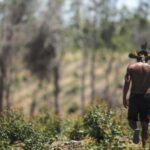Due diligence is one of the most important steps in the investment process. It determines whether to invest, and after an investment, can support a smooth transition and eventual success. If not conducted appropriately, an eventual investment can experience all kinds of challenges. This article breaks down the characteristics that comprise a high-quality forestry ESG due diligence for direct investments, so that not only can you select the right investments with confidence, but you can also set them on their way to a profitable and impactful future.

Due Diligence in the Investment Process
Different investment organizations structure their investment process in different ways, but in short – they all contain the same building blocks:

Until recently, considering ESG in the forest investment process has been more of a box ticking exercise in due diligence. It would appear during the holding period by way of a sustainability report, or a narrative on how an investment has achieved forest management certification. With sustainability regulatory requirements (EU SFDR, California climate data accountability act), voluntary standards for best practice in the financial sector (GHG Protocol, TNFD, TCFD, IFC E&S), and general shareholder favor (Net-Zero Asset Owner Alliance) – ESG’s role in the investment process is expanding. ESG factors are now not only seen as risk factors, but as sustainability objectives. Investors in their strategies are creating environmental, social and governance objectives and targets – and thus, also need to assess an investment opportunity’s ability to perform on sustainability criteria.
The 5 Pillars of High-Quality Forestry ESG Due Diligence
In the following list, I identify 5 key steps (and what to include in those steps) to make for effective ESG Due Diligence. Designing the process begins in the strategy design phase, with the first two steps of standards alignment and ESG Policy design, setting the foundation for your strategy’s position on ESG. The following two phases involve active evaluation of deals, and the final stage of due diligence will dictate how your ESG due diligence findings are structured into how ESG will be managed after the transaction – how your sustainability objectives will be met, and how ESG risks you identified will be avoided or mitigated. Let’s look at each.
1. Standards Alignment
Assuming your commercial and sustainability objectives have been defined, as you progress in the defining of your investment strategy, you will identify different standards that your investments will comply and align with. These might be certain regulatory requirements, best practice standards or policies held by either your existing investment partners or prospective anchor investors. For the financial sector, these might be the Standards introduced above. Specifically relevant for forestry, it might be alignment with specific forest management certification standards, such as FSC, PEFC or SFI, or on the processing side, might include IFC’s industry-specific environmental, health and safety guidelines, or for the bioenergy industry, it could be certification under the Sustainable Biomass Program. Further, you will have unique standards to your investment strategy – that may relate to the forest assets you will invest into, the end markets you will target, and the geographies where your investments will take place. From an ESG standpoint You will need to analyze and synthesize this web of mandatory and voluntary requirements into an articulated set of ESG Standards that your investment strategy will build into its ESG Policy, and eventual Environmental and Social Management System (ESMS).
2. ESG Policy
Following on the Standards Alignment is organizing these synthesized Standards into your ESG rules of engagement, or your ESG Policy. On the environmental side, this may include elaboration on such rules as no deforestation or no ecosystem conversion. On the social side, it may be to engage affected Indigenous communities in Free, Prior and Informed Consent. On the governance side, it may be to not participate in corruption in any form. Though abbreviated, it gives you an idea of the type of content to consider (all stemming from the standards and your organization’s investment philosophy designed in the previous step). You will then need to convert this Policy into an actionable ESMS, of which the following three steps are part.
3. Origination and Screening
Once the ESG rules of engagement, or ESG Policy, is defined, you are ready to design your screening process. Forest investment due diligence is an investment in itself – as it often entails travel, hiring of topical experts and legal and tax advice. Not to mention, it can take a lot of time. Before you invest the time and money into due diligence, it is wise to efficiently screen opportunities that cross your desk. In a small contradiction, you may want to invest in a fact-finding mission at this stage. Visiting some opportunities or existing businesses on the ground, will help you to gain an understanding of how your ESG Policy would play out in real assets. Fact-finding aside, you will want to develop a screening checklist to run new opportunities against. The content of this screening checklist will follow the format of your ESG Policy, touching on the various ESG factors that are relevant to your strategy. An important outcome of the ESG screening process is to uncover if any of the assets being evaluated don’t meet minimum eligibility criteria of your ESG Policy and that there are opportunities for meeting your impact objectives. For example, if the asset has been associated with deforestation and you have a line drawn in the sand in not being associated with such practice – you need go no further in exploring the asset. Other important outcomes are identifying potential ESG risks and opportunities that warrant deeper digging in due diligence – it could recommend a particular study – for example a socioeconomic evaluation, or biodiversity baseline. On the governance side, it might be a legal review of the corporate governance of your future investment partners/operators. Effective screening, which can be conducted with little more than your computer and a good internet connection, can be completed in a couple of weeks. It will save you time and money and allow you to focus on the more detailed elements in due diligence.
4. Due Diligence
The ESG due diligence phase will be much more comprehensive than screening. It is sometimes broken down into phases, where in the first phase, it is conducted by your investment team, and in later stages, commits more funding and time in the hiring of experts that I mentioned above. Due diligence starts with a more detailed due diligence questionnaire – again extracted from your ESG Policy. To build your due diligence questionnaire, it is useful to extract the criteria from the best practice and regulatory standards that are foundational to your strategy. It will require you to consider and rate the material risk of the different ESG aspects considered. In this process, drawing special attention to medium and high-risk elements – discern if the risk ratings are perceived (you don’t have enough information) or real (the information tells you this). Medium and high risks may warrant a more detailed due diligence and/or specific mitigation measures that you would turn into requirements to invest. For example, imagine you uncover a serious workplace accident that has occurred in the recent past, to prevent this from happening on your watch, already in due diligence, you would set the wheels in motion for identifying the need for more robust occupational health and safety policies and procedures. You will also want to consider in more detail the impact opportunities with the asset, and what I refer to as the impact-profit conflict analysis. In the end, you will prepare a summary that indicates the strong points and impact thesis, the medium and high risks and what is to be done about them, and internal issues you might face. The decision might be to walk away from the investment.
A word to the wise – if declining the investment is your chosen path, and you have spent considerable time assessing an opportunity, please give adequate feedback to the deal proponent! I’ve seen time and time again, solid and sustainable forest businesses invest significant time and money in following an investor’s due diligence – to be declined investment without significant reason. I would argue that as an investor in the space, you have a responsibility to improve it, and that includes doing your part to explain why you’re not investing, in concrete terms, so the forest business can improve on those elements (assuming it is something they have control over). In a similar vein, if you choose to invest, and the asset still requires more capital – you may consider making some of your due diligence material available to other interested parties. This will help your investment and builds rapport with your future investment partners.
5. Transition
Transition looks different depending on the type of investment you’re making. If you are a debt provider or minority shareholder that will have little control over the investment once you’ve committed – your transition requirements need to surface in the terms and conditions of your investment. If you’re a majority equity partner, in addition to terms and conditions, there might be a longer transition plan agreed with your investee – where your ESG requirements are structured over time into their regular operations. Whatever the case, transition is about extracting the medium and high risks that aren’t deal breakers, but must be addressed upon investment. It’s also about taking your ESG Policy and making it actionable by your investee. Your job in this phase is to take your due diligence summary and re-purpose it into action steps for ESG integration and implementation. Ensuring that these steps are taken, following up on them and adapting as the real-world context dictates – is how you bring your due diligence to a close and put your investment on the path to success.
Need support with your Forestry ESG Due Diligence?
Whether you’re in the investment strategy design phase and formulating your ESG Policy framework, are actively assessing deals, or wondering how to effectively integrate your ESG requirements into your investee onboarding I can help you and your team with the tools needed to set your forest investments on the path for success. Please reach out if you’d like to explore how I can help.
Did you like this article? Sign up now for the ForestLink’s newsletter, where you’ll receive technical advice, reflections, and best-practice guidance to support you with your forest-linked investment strategy or business straight to your inbox.





